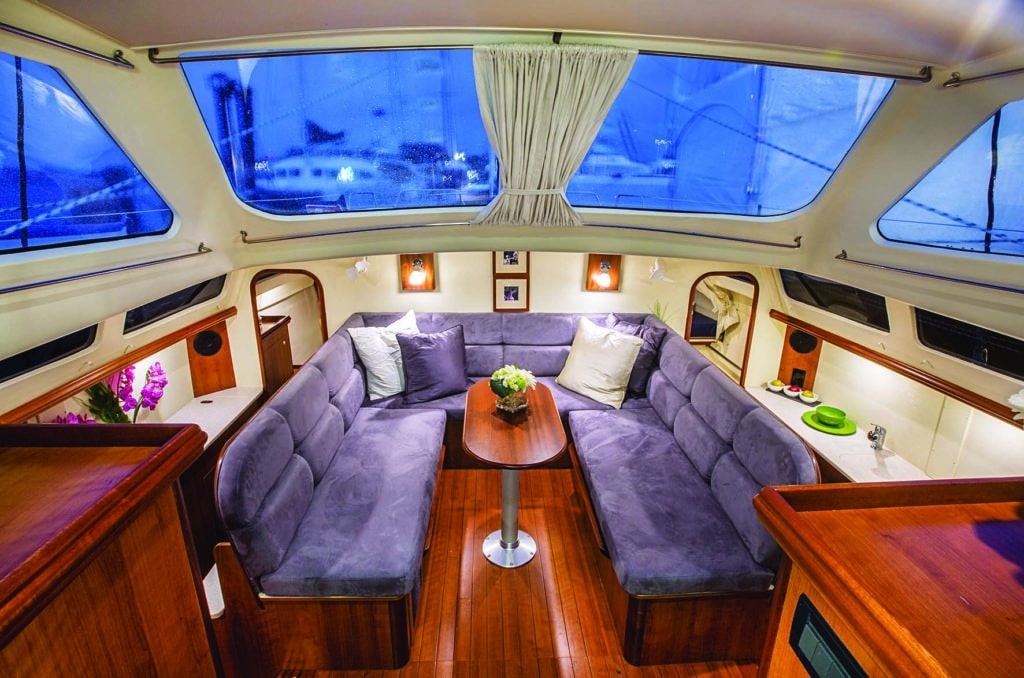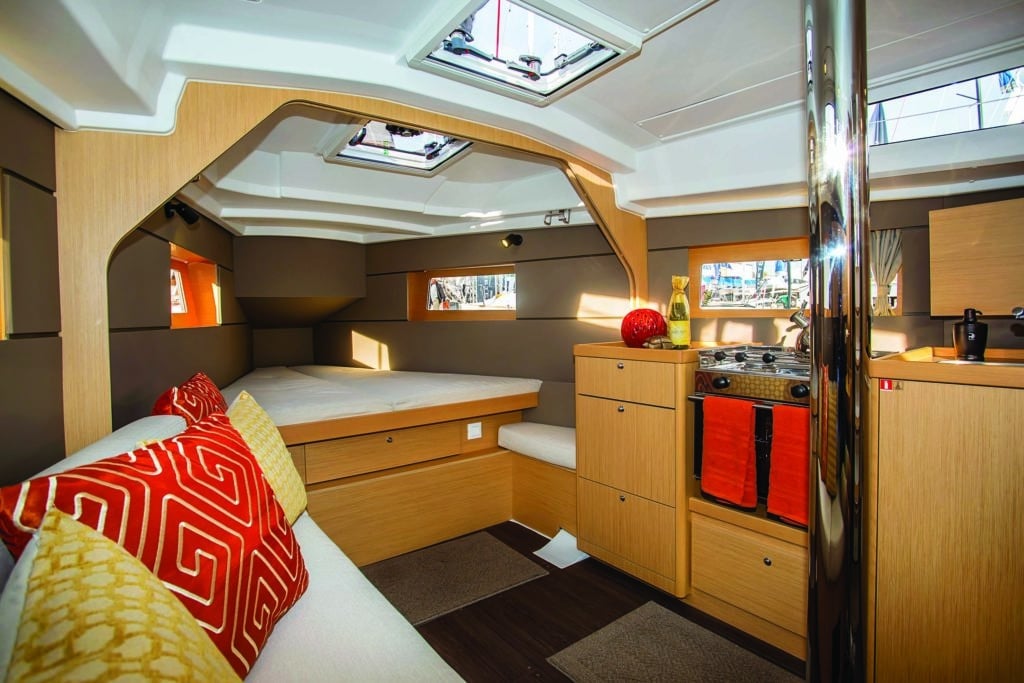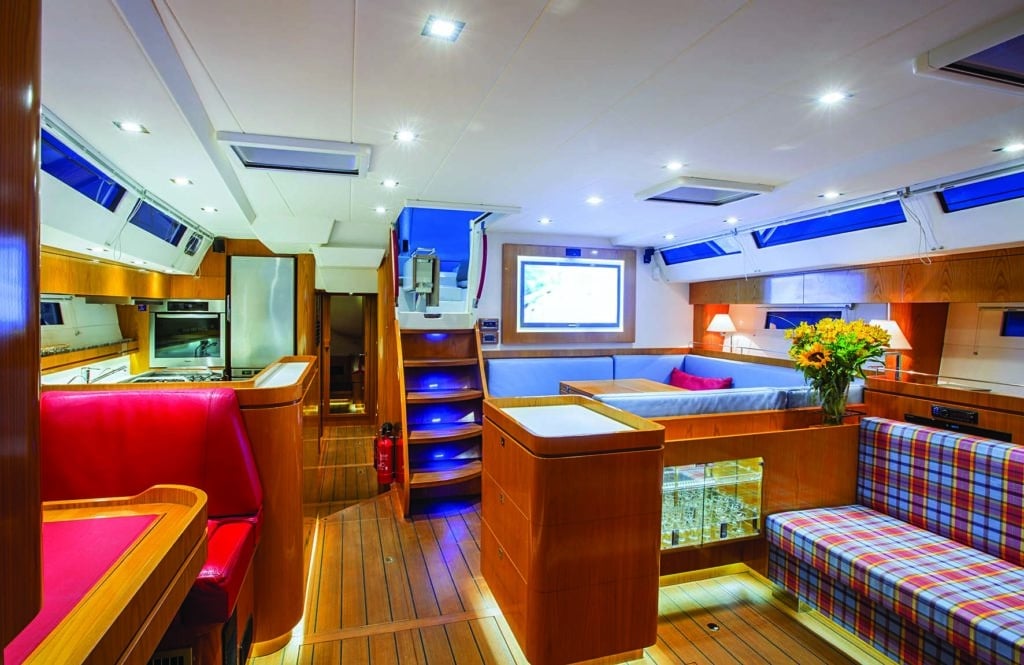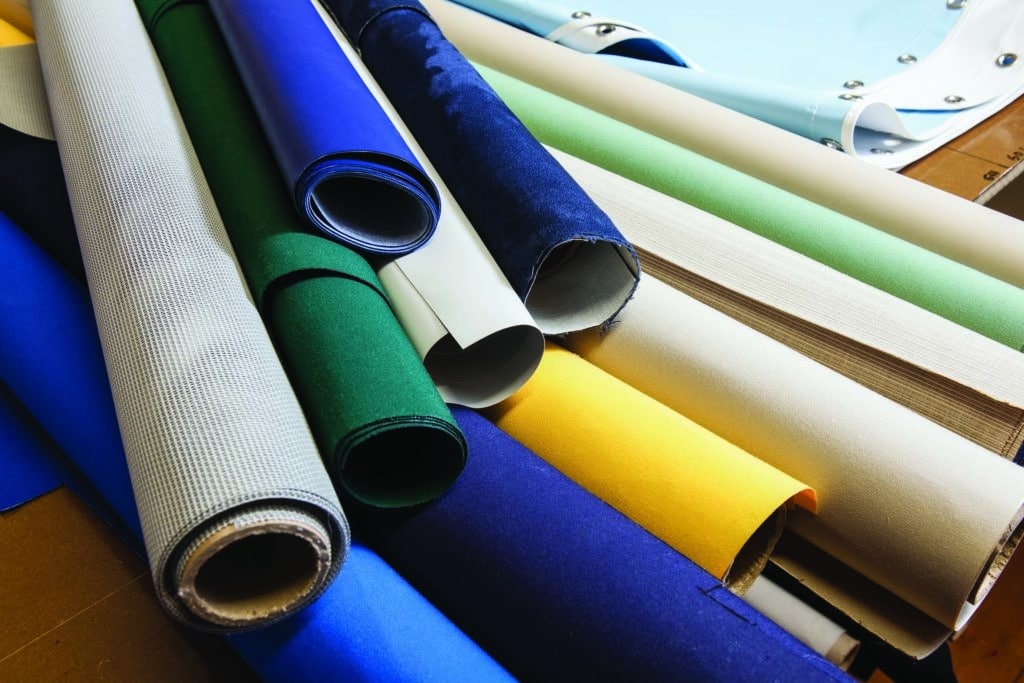
Perhaps nothing can change the look and feel of a boat quite as profoundly as new cushions or canvas. Whether you’re updating your saloon, installing a new dodger or fitting a new mainsail cover, new canvas work is an investment and not something you want to repeat frequently. So it’s important to pick the right materials for the project the first time. With the abundance of options available, though, how do you know what will be up to the task?
To sort through this, and to get ideas for my own boat, I reached out to some experts in the field of marine canvas work — Matt Grant, vice president of Sailrite; Kate Gable Seremeth, yacht interior designer; and Jeff Serrie, owner of Island Marine Canvas in Newport, Rhode Island — to get their take on how to choose the right fabric for the job.
The Inside Job
Everyone I spoke with agrees that the saloon and cabins are where you should have some fun with your fabric choices. “Saloon cushions and other cushions inside your boat are a place where you can get creative with different fabric patterns and textures,” says Grant. “Don’t be afraid to mix and match different types of materials to create interest. The primary importance, however, should be selecting a fabric that will be durable enough for a boat. This includes moisture and fade resistance. It’s also a great idea to choose a fabric that will be easy to clean.”
From the interior design perspective, Seremeth adds: “Although fabric can be a finishing touch, it also makes a strong statement down below and above deck. If it is a refit, I try to be very conscious of the existing mood of the boat and try to let the fabric fit in. What is the focal point of the boat? Do I want to grab attention from that or keep the upholstery subtle so as not to distract too much?”
Some fabric choices for interior cushions include Sunbrella, which has an upholstery line specifically for this purpose; if you prefer a leather look, check out Nauga Soft by Uniroyal, or one of the many Ultraleather products. “Be mindful that Ultraleather is expensive relative to other options, but it is the only choice for a true leather look and feel while having the characteristics desired within a boat,” Grant notes.

Beyond the brand names, qualities you should look for in fabrics include high double-rub ratings (a measure of abrasion resistance, with 30,000-plus being very good) and fade resistance (search for solution-dyed fabric, which means the color runs to the yarn’s core). Restrict the options to a marine-appropriate fiber type (acrylic, polyester, olefin, PVC or polyurethane).
What are some pitfalls to avoid? Whether you’re planning to do the project yourself or hire someone to do it for you, request fabric samples beforehand. “You want to see the actual colors in your boat, and know that the material is something that you can work with,” Serrie says. “If you’re purchasing material from a fabric store, consider bringing a piece to your canvas guy first to make sure that it’s suitable for the intended purpose. If you’re sewing it yourself, try running a sample through your machine first.”
Grant recommends that you select the best fabric and foam you can. “The wrong fabric will fade prematurely and perhaps sun rot, or even transfer colors to other surfaces,” he says. “Poor-quality foam may break down more quickly and no longer be comfortable, or if not covered properly it can become a heavy, water-saturated brick and mildew quickly.”
Don’t forget to consider your lifestyle and plans when choosing your fabrics, and think about the durability of the fabric. When working on a project, Seremeth asks questions such as whether the cruisers have children, grandchildren or pets. “I always choose fabrics that are highly durable for the seat cushions, and if there is a pattern or fabric that the client and I are in love with but isn’t as durable, I will place that fabric on a pillow or something that can be easily replaced,” she says.
Another option if you’re concerned with cushion breathability or fabric cost is to use a different material on the bottoms. “If a cushion can be flipped, use the primary fabric on both the top and bottom surfaces,” Grant said. “But if the cushion won’t be flipped, consider saving a little by using cushion underlining fabric on the bottom. This will help with breathability, and it also sticks a bit to help keep the cushion from sliding.”

The Outdoor Life
The materials you use for projects on deck can have a big impact on your day-to-day living in terms of comfort and resistance to sun exposure. “Sunbrella is a favorite for good reason,” Serrie says. “It’s versatile, holds up well, is breathable and is available in a wide variety of colors and patterns. The downsides are that it’s not very chafe resistant, so you’ll want to reinforce high-chafe areas, and the initial water-resistant coating does wear off, so you’ll need to periodically use a waterproofing spray like 303 Fabric Guard.”
If having a completely waterproof dodger or bimini is important to you, an alternative to a woven material like Sunbrella is a vinyl material such as Stamoid or Weblon Regatta. These fabrics offer a nice, clean look, stay waterproof, and are very durable.
“There are some premium fabric alternatives that feature a base of Sunbrella fabric that has been ‘improved upon,’ but these should be carefully discussed with your fabric supplier before making a selection,” Grant advises. “Most of these options improve the water resistance of the product or simply change its aesthetic.”
When it comes to sail covers, stick to a woven material like Sunbrella because breathability and UV resistance are key for protecting your sails and keeping them mildew free.
If you will be cruising in tropical climes and plan to spend lots of time in the cockpit, consider adding a sunshade for use at anchor. A loosely woven vinyl mesh such as Textilene performs well for this purpose because you can still see through it and feel a breeze, yet not have the glare from the sun in your eyes.
As with most projects, don’t overlook the details when doing canvas work. Your choice of thread can literally make or break your results. “Using the wrong thread is a very bad idea,” Grant says. “If the thread fails, the seams separate and edges have a tendency to get ripped before the item can be resewn. Use only UV-resistant polyester thread for outdoor projects. Make sure to select the correct size. For saloon projects use either polyester thread or a UV-treated nylon thread. Nylon stretches better than polyester, so for stretchy interior fabric selections it is the correct product.” Also be sure to stick to marine-quality zippers, and in particular, make sure the zippers for outside use are UV treated.

Cushion Comfort
The foam you fill your cushions with is just as important (if not more so) than the fabric covering it. Choose poorly and your cushions could be uncomfortable and misshapen before their time. Or worse, full of mildew.
In general, the foam options for use on board are closed-cell foam, polyurethane foam, dry-fast foam and latex foam. Polyurethane foam is the most common choice for interior cushions. When selecting polyurethane foam, be aware of the density rating (measured in pounds), which will give you an idea about its quality and longevity, and the firmness (usually described as soft, medium or firm). For cushions that will see heavy use, consider a 2-pound density or higher. “Be careful when purchasing your foam, and use a reputable vendor,” Serrie says. “Quality foam can be hard to find, and you get what you pay for.”
Grant agrees: “When it comes to foam for the cushions, spend as much as you can afford. The foam and batting will be the first to lose shape and provide inadequate support. Look for higher density when using polyurethane foam, and be sure it has an antibacterial agent. Polyurethane foam will hold moisture, so I recommend wrapping it with a thin plastic barrier, called silk film, if the cushion will see wet bathing suits. Don’t forget to use high-quality polyester batting to round out your cushions to a pleasing shape and to help fill out corners.”
Closed-cell foam, also called flotation foam, is extremely firm and dense (think life jackets), and is a good choice for cockpit cushions since it is nonabsorbent and floats. Quick-dry foam is another option for either interior or exterior uses. Due to its structure, liquid can flow right through it, so cushions won’t stay soggy if they get wet. This type of foam is also extremely breathable and is a nice choice for a mattress if you cruise in the tropics. Keep in mind, though, that if you use this type of foam for cockpit cushions, it does not float. Latex foam is typically used just for mattresses. While pricey, it is very durable and naturally resistant to mold, mildew, bacteria and dust mites.
Whether you do it yourself or go with a pro, updating your boat’s canvas and upholstery is a great way to give it a completely new look. Overwhelmed by the color and pattern choices? Yacht interior designer Seremeth says to just take a chance. “Upholstery is one of the few things on a boat that can be easily changed — so why not have fun with it?”
Resources:
Island Marine Canvas, Newport, RI
Track Studios | Kate Seremeth
– – –
Jen Brett is CW’s senior editor








